Polyimide (PI) Composite Spunlace Nonwovens for Hygiene Material with Excellent Comfort and Antimicrobial Properties
Abstract
:1. Introduction
2. Materials and Methods
2.1. Materials
2.2. Preparation
2.2.1. Preparation of PI Composite Spunlace Nonwoven Fabric
2.2.2. Plasma Treatment of 5-P
2.3. Characterization
2.4. Antibacterial Properties
3. Results
3.1. Preparation of PI Composite Spunlace Nonwoven Fabric
3.2. Plasma Treatment of 5-P
3.3. XPS Analysis
3.4. Comfort Properties
3.4.1. Air Permeability
3.4.2. Liquid Conductivity
3.5. Mechanical Properties
3.6. Antimicrobial Properties
4. Conclusions
Author Contributions
Funding
Data Availability Statement
Acknowledgments
Conflicts of Interest
References
- Barman, A.; Katkar, P.M.; Asagekar, S.D. Natural and Sustainable Raw Materials for Sanitary Napkin. J. Text. Sci. Eng. 2017, 7, 3. [Google Scholar]
- Das, D. Composite Nonwovens in Absorbent Hygiene Products. In Composite Non-Woven Materials; Woodhead Publishing: Cambridge, UK, 2014; pp. 74–88. [Google Scholar]
- Atasağun, H.G.; Kara, S. Investigation of Moisture Management and Frictional Characteristics of Top Layers Used in Disposable Absorbent Hygiene Products. Fibers Polym. 2022, 23, 2577–2585. [Google Scholar] [CrossRef]
- Miao, D.; Cheng, N.; Wang, X.; Yu, J.; Ding, B. Sandwich-Structured Textiles with Hierarchically Nanofibrous Network and Janus Wettability for Outdoor Personal Thermal and Moisture Management. Chem. Eng. J. 2022, 450, 138012. [Google Scholar] [CrossRef]
- Xiao, Y.-Q.; Kan, C.-W. Review on the Development and Application of Directional Water Transport Textile Materials. Coatings 2022, 12, 301. [Google Scholar] [CrossRef]
- Ajmeri, J.R.; Ajmeri, C.J. Nonwoven Personal Hygiene Materials and Products. In Applications of Nonwovens in Technical Textiles; Woodhead Publishing: Cambridge, UK, 2010; pp. 85–102. [Google Scholar]
- Cheng, H.; Han, N.; Bai, Z.; Li, Z.; Xu, W.; Xiao, S. Ag-Decorated PP Nonwoven for Excellent Catalytic Reduction of 4-Nitrophenol and Antibacterial Study. Surf. Interfaces 2023, 39, 102929. [Google Scholar] [CrossRef]
- Yadav, S.; Illa, M.P.; Rastogi, T.; Sharma, C.S. High Absorbency Cellulose Acetate Electrospun Nanofibers for Feminine Hygiene Application. Appl. Mater. Today 2016, 4, 62–70. [Google Scholar] [CrossRef]
- Sun, L.; Feng, Y.; Qian, X. Preparation and Properties of Wormwood Extract/Viscose Spunlaced Nonwovens. J. Text. Inst. 2021, 112, 709–717. [Google Scholar] [CrossRef]
- Wu, Y.; Yang, S.; Fu, F.; Zhang, J.; Li, J.; Ma, T.; Liu, X.; Yao, J. Amino Acid-Mediated Loading of Ag NPs and Tannic Acid onto Cotton Fabrics: Increased Antibacterial Activity and Decreased Cytotoxicity. Appl. Surf. Sci. 2022, 576, 151821. [Google Scholar] [CrossRef]
- Wang, Y.; Liu, X.; Yang, R.; Ma, Q. Asymmetric Wetting and Antibacterial Composite Membrane Obtained by Spraying Bacterial Cellulose Grafted with Chitosan for Sanitary Products Surface Layers. Carbohydr. Polym. 2021, 256, 117602. [Google Scholar] [CrossRef]
- Iqbal, W.; Yexiong, Q.; Yaming, J.; Owais Raza Siddiqui, M.; Khalid, R.; Iqbal, A.; Usman Munir, M.; Hussain, A.; Xu, S. Antimicrobial Property of Functional Viscose Fibre by Using Mint Extract. Ind. Textila 2023, 74, 464–469. [Google Scholar] [CrossRef]
- Agrawal, N.; Low, P.S.; Tan, J.S.J.; Fong, E.W.M.; Lai, Y.; Chen, Z. Durable Easy-Cleaning and Antibacterial Cotton Fabrics Using Fluorine-Free Silane Coupling Agents and CuO Nanoparticles. Nano Mater. Sci. 2020, 2, 281–291. [Google Scholar] [CrossRef]
- Lian, L.; Pang, C.; Wei, H.; Hong, L. Citronellol-Based Long-Lasting Antibacterial Cotton Fabrics without Bacterial Resistance. Macromol. Biosci. 2023, 23, 2300169. [Google Scholar] [CrossRef]
- Cheng, W.; Yu, Y.; Liu, W.; Wang, X.; Zhou, M.; Xu, B.; Wang, P.; Wang, Q. Self-Assembly Amino-Quinone Network Coatings onto Polyester Fabric via Single-Sided Spraying of Natural Polyphenols and Polyethyleneimine for Highly Efficient Moisture Conducting and Bacteriostatic Properties. Appl. Surf. Sci. 2022, 606, 154913. [Google Scholar] [CrossRef]
- Liu, J.; Lin, X.; Liang, H. Dyed Fabrics Modified via Assembly with Phytic Acid/Berberine for Antibacterial, UV Resistance, and Self-Cleaning Applications. J. Eng. Fibers Fabr. 2019, 14, 155892501988897. [Google Scholar] [CrossRef]
- He, H.; Qin, Y.; Zhu, Z.; Jiang, Q.; Ouyang, S.; Wan, Y.; Qu, X.; Xu, J.; Yu, Z. Temperature-arousing self-powered fire warning e-textile based on p-n segment coaxial aerogel fibers for active fire protection in firefighting clothing. Nano-Micro Lett. 2023, 15, 226. [Google Scholar] [CrossRef]
- Yu, Z.; Wan, Y.; Qin, Y.; Jiang, Q.; Guan, J.P.; Cheng, X.W.; Wang, X.; Ouyang, X.; Qu, X.; Zhu, Z.; et al. High fire safety thermal protective composite aerogel with efficient thermal insulation and reversible fire warning performance for firefighting clothing. Chem. Eng. J. 2023, 477, 147187. [Google Scholar] [CrossRef]
- Wang, Q.; Bai, Y.; Xie, J.; Jiang, Q.; Qiu, Y. Synthesis and Filtration Properties of Polyimide Nanofiber Membrane/Carbon Woven Fabric Sandwiched Hot Gas Filters for Removal of PM 2.5 Particles. Powder Technol. 2016, 292, 54–63. [Google Scholar] [CrossRef]
- Wang, L.; Cui, L.; Liu, Y.; Riedel, J.; Qian, X.; Liu, Y. Electrospun Polyimide Nanofiber-Coated Polyimide Nonwoven Fabric for Hot Gas Filtration. Adsorpt. Sci. Technol. 2018, 36, 1734–1743. [Google Scholar] [CrossRef]
- Qiao, S.; Kang, S.; Zhu, J.; Wang, Y.; Yu, J.; Hu, Z. Facile Strategy to Prepare Polyimide Nanofiber Assembled Aerogel for Effective Airborne Particles Filtration. J. Hazard. Mater. 2021, 415, 125739. [Google Scholar] [CrossRef]
- Yang, X.; Ma, W.; Lin, H.; Ao, S.; Liu, H.; Zhang, H.; Tang, W.; Xiao, H.; Wang, F.; Zhu, J.; et al. Molecular Mechanisms of the Antibacterial Activity of Polyimide Fibers in a Skin-Wound Model with Gram-Positive and Gram-Negative Bacterial Infection in Vivo. Nanoscale Adv. 2022, 4, 3043–3053. [Google Scholar] [CrossRef]
- Song, Y.; Chen, X.; Xu, K.; Li, H.; Xu, Y.; Wu, H.; Wu, J.; Huang, C. Green and Scalable Fabrication of Nonwoven Composites Featured with Anisotropic Water Penetration. ACS Sustain. Chem. Eng. 2019, 7, 19679–19685. [Google Scholar] [CrossRef]
- Zhang, H.; Shen, Y.; Edgar, K.J.; Yang, G.; Shao, H. Influence of Cross-Section Shape on Structure and Properties of Lyocell Fibers. Cellulose 2021, 28, 1191–1201. [Google Scholar] [CrossRef]
- Adnan, M.; Moses, J. A Study on the Thermophysiological and Tactile Comfort Properties of Silk/Lyocell Blended Fabrics. Matéria 2020, 25, e12796. [Google Scholar] [CrossRef]
- Hanh Le, T.M.; Singto, S.; Sajomsang, W.; Mongkolnavin, R.; Nuisin, R.; Painmanakul, P.; Sairiam, S. Hydrophobic PVDF Hollow Fiber Membrane Modified with Pulse Inductively Coupling Plasma Activation and Chloroalkylsilanes for Efficient Dye Wastewater Treatment by Ozonation Membrane Contactor. J. Membr. Sci. 2021, 635, 119443. [Google Scholar] [CrossRef]
- Kan, C.; Lam, Y. The Effect of Plasma Treatment on Water Absorption Properties of Silk Fabrics. Fibers Polym. 2015, 16, 1705–1714. [Google Scholar] [CrossRef]
- Urbaniak-Domagala, W.; Krucinska, I.; Wrzosek, H.; Komisarczyk, A.; Chrzanowska, O. Plasma Modification of Polylactide Nonwovens for Dressing and Sanitary Applications. Text. Res. J. 2016, 86, 72–85. [Google Scholar] [CrossRef]
- Liu, X.; Wang, C.; Liu, J.; Wang, G.; Yang, Z.; Chen, F.; Song, J. Comparative Study of Surface Modification of Polyethylene by Parallel-Field and Cross-Field Atmospheric Pressure Plasma Jets. J. Appl. Phys. 2019, 125, 123301. [Google Scholar] [CrossRef]
- Kim, J.H.; Han, J.H.; Hong, S.; Kim, D.-W.; Park, S.H.; Wee, J.-H.; Yang, K.S.; Kim, Y.A. Effect of Plasma Surface Modification on Pullout Characteristics of Carbon Fiber-Reinforced Cement Composites. Carbon Trends 2021, 3, 100030. [Google Scholar] [CrossRef]
- Khoo, Y.S.; Lau, W.J.; Liang, Y.Y.; Karaman, M.; Gürsoy, M.; Ismail, A.F. Eco-Friendly Surface Modification Approach to Develop Thin Film Nanocomposite Membrane with Improved Desalination and Antifouling Properties. J. Adv. Res. 2022, 36, 39–49. [Google Scholar] [CrossRef]
- Dhanumalayan, E. Studies on the Surface and Wetting Properties of Poly (Vinylidene Fluoride)/Poly (Acrylonitrile)/Multiwalled Carbon Nanotube-NH2 Blends as a Function of Air Plasma Treatment. J. Mater. Eng. Perform. 2021, 30, 7343–7353. [Google Scholar] [CrossRef]
- Said, N.; Khoo, Y.S.; Lau, W.J.; Gürsoy, M.; Karaman, M.; Ting, T.M.; Abouzari-Lotf, E.; Ismail, A.F. Rapid Surface Modification of Ultrafiltration Membranes for Enhanced Antifouling Properties. Membranes 2020, 10, 401. [Google Scholar] [CrossRef]
- ASTM D737-18; Standard Test Method for Air Permeability of Textile Fabrics. ASTM: West Conshohocken, PA, USA, 2023.
- GB/T 30133-2014; General Technical Specification for Surfaces for Sanitary Napkins. China Standard Press: Beijing, China, 2014.
- GB/T 15979-2002; Hygienic Standard for Disposable Sanitary Articles. China Standard Press: Beijing, China, 2002.
- Ding, C.; Chen, C.; Yuan, Z.; Chen, L. Molecular Simulation of the Effect of Plasma Modification on the Microscopic Properties of Polyimide. Front. Mater. 2022, 9, 1018882. [Google Scholar] [CrossRef]
- Yang, D.; Lin, W.; Xin, B.; Miao, Y.; Chen, X. Research on the Surface Roughness of Aramid Fibers via the Surface Modification. J. Text. Inst. 2021, 112, 1743–1752. [Google Scholar] [CrossRef]
- Xu, Z.; Cheng, C.; Shen, J.; Lan, Y.; Hu, S.; Han, W.; Chu, P.K. In Vitro Antimicrobial Effects and Mechanisms of Direct Current Air-Liquid Discharge Plasma on Planktonic Staphylococcus Aureus and Escherichia Coli in Liquids. Bioelectrochemistry 2018, 121, 125–134. [Google Scholar] [CrossRef]
- Patange, A.D. Inactivation Efficacy of Atmospheric Air Plasma and Airborne Acoustic Ultrasound against Bacterial Biofilms. Sci. Rep. 2021, 11, 2346. [Google Scholar] [CrossRef]
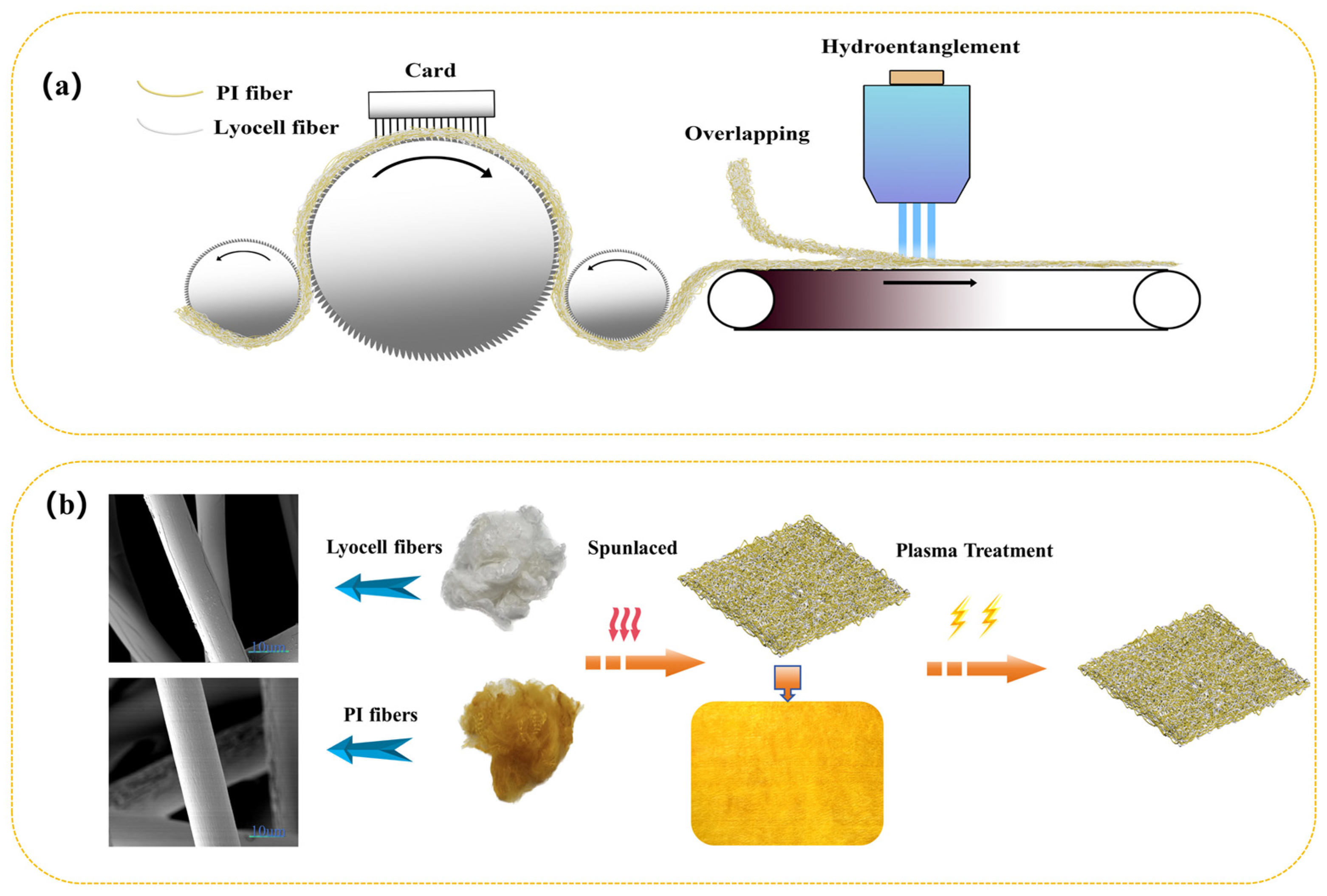

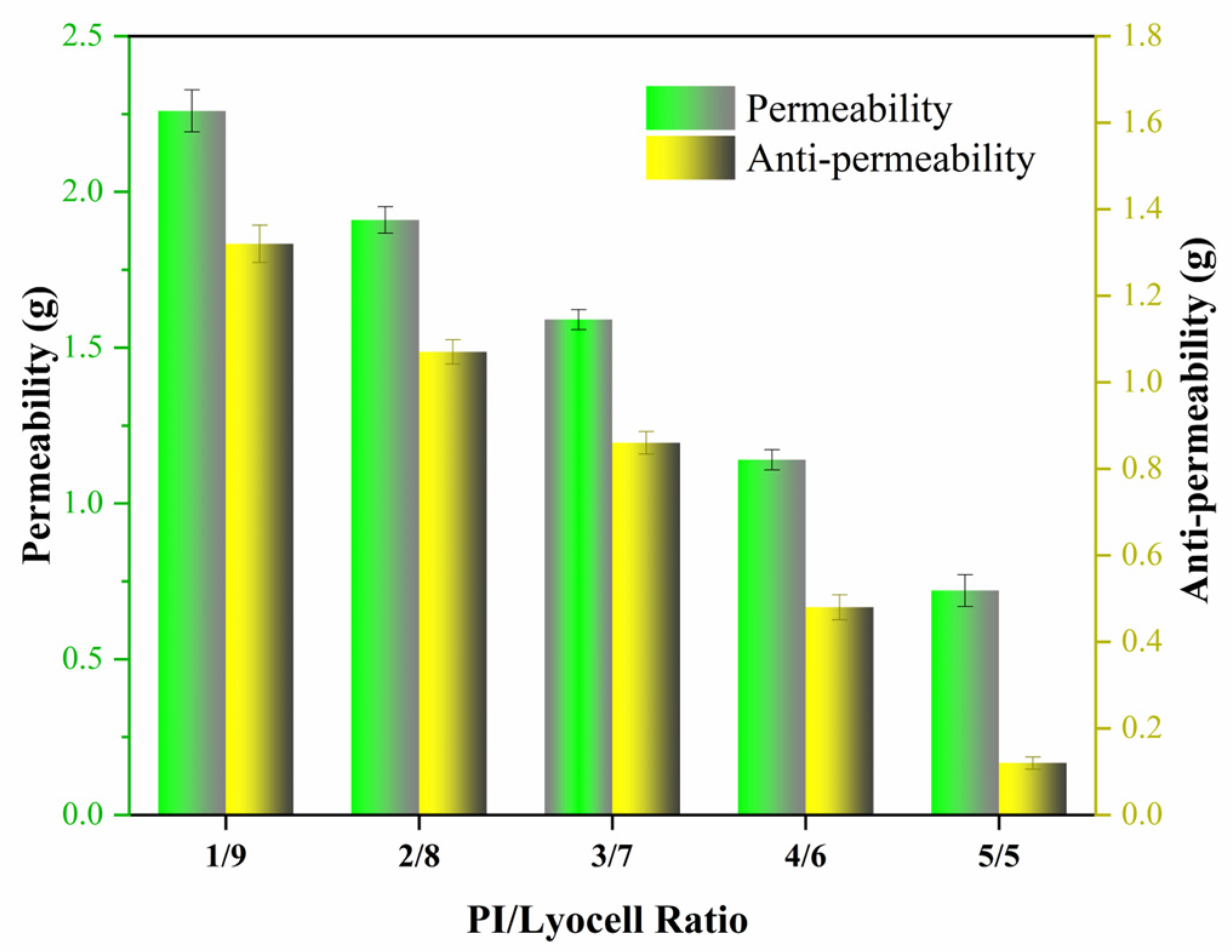
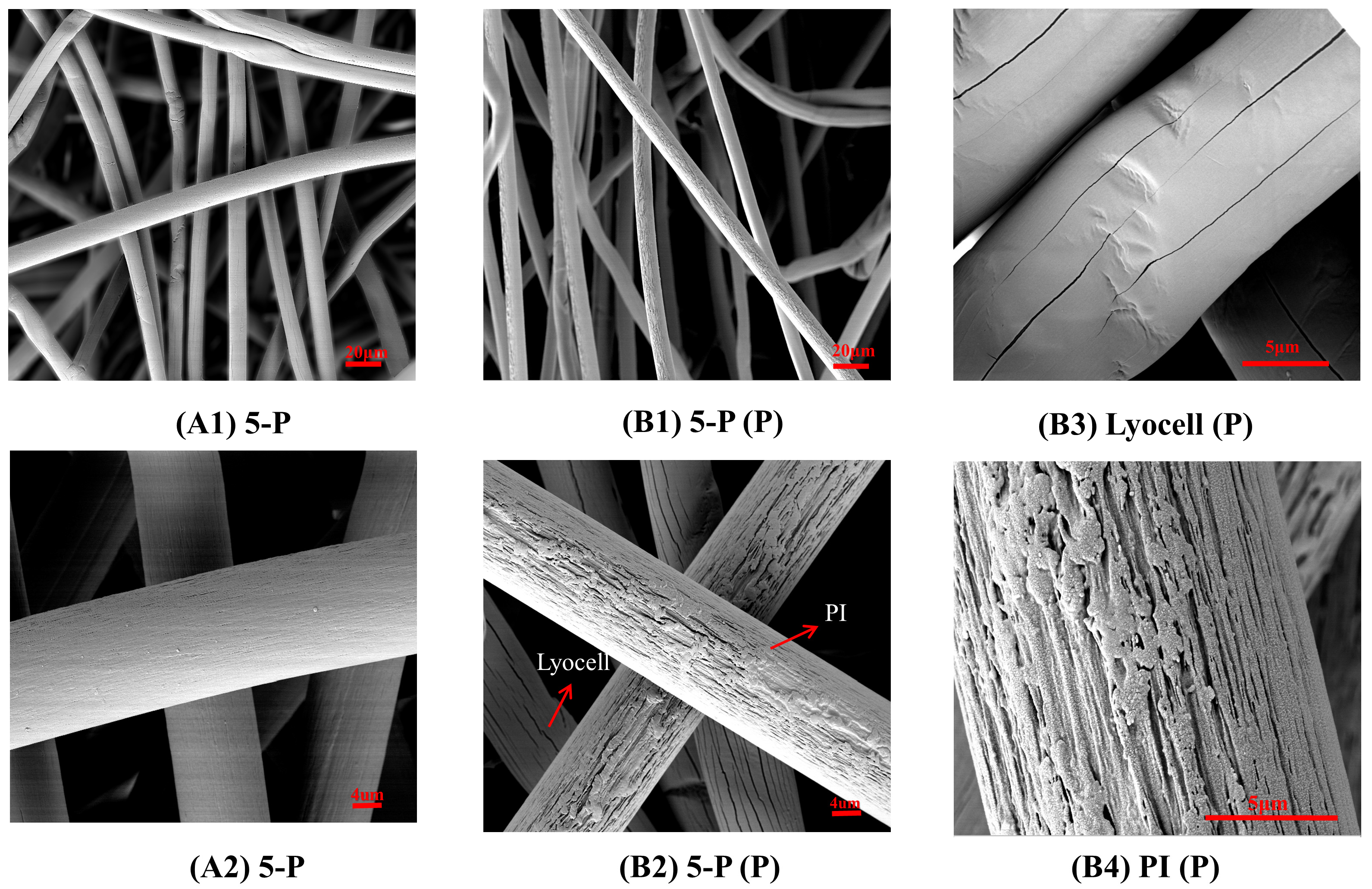

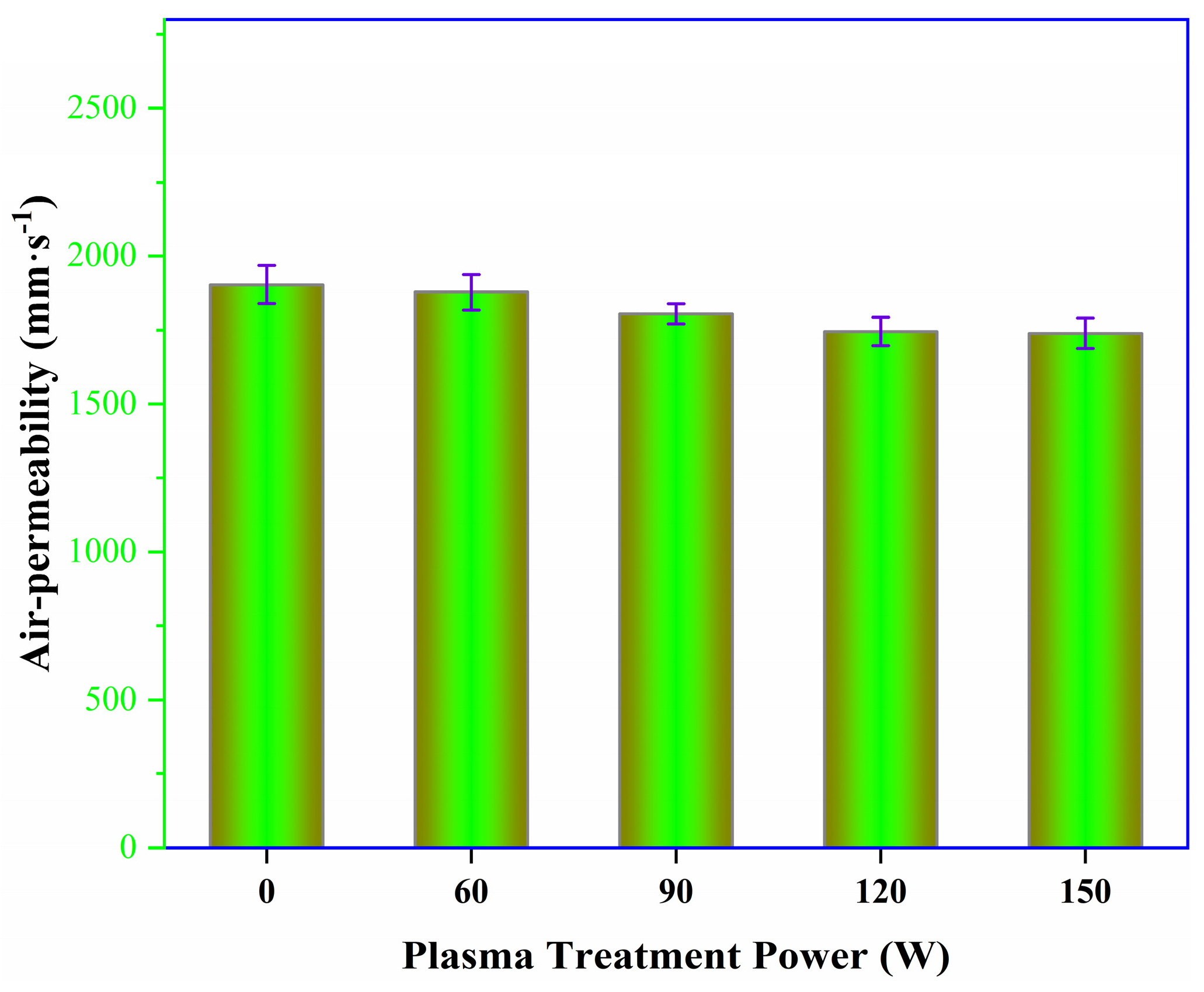
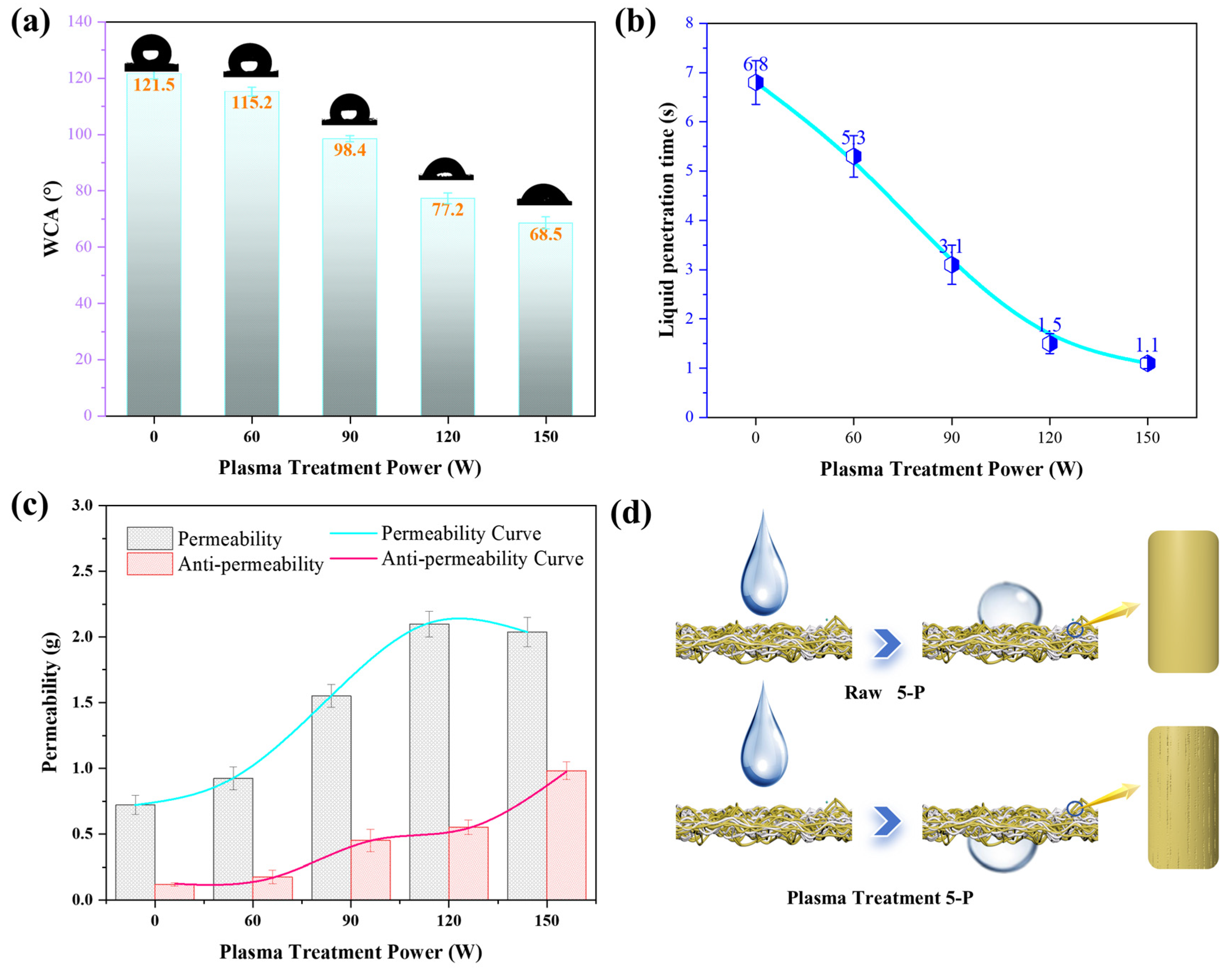




| PI/lyocell Ratio | Air Permeability (mm·s−1) | Tensile Strength (N) |
|---|---|---|
| 1/9 | 1806 | 30.24 |
| 2/8 | 1827 | 32.68 |
| 3/7 | 1839 | 35.36 |
| 4/6 | 1856 | 34.57 |
| 5/5 | 1906 | 35.58 |
| Element Content/%, Atomic Fraction | |||
|---|---|---|---|
| C | N | O | |
| Untreated Sample | 77.53 | 1.37 | 21.1 |
| Treated Sample | 80.15 | 0.81 | 19.04 |
Disclaimer/Publisher’s Note: The statements, opinions and data contained in all publications are solely those of the individual author(s) and contributor(s) and not of MDPI and/or the editor(s). MDPI and/or the editor(s) disclaim responsibility for any injury to people or property resulting from any ideas, methods, instructions or products referred to in the content. |
© 2024 by the authors. Licensee MDPI, Basel, Switzerland. This article is an open access article distributed under the terms and conditions of the Creative Commons Attribution (CC BY) license (https://creativecommons.org/licenses/by/4.0/).
Share and Cite
Lu, H.; Lin, M.; Li, T.; Zhang, H.; Feng, L.; Zhang, C. Polyimide (PI) Composite Spunlace Nonwovens for Hygiene Material with Excellent Comfort and Antimicrobial Properties. Processes 2024, 12, 354. https://doi.org/10.3390/pr12020354
Lu H, Lin M, Li T, Zhang H, Feng L, Zhang C. Polyimide (PI) Composite Spunlace Nonwovens for Hygiene Material with Excellent Comfort and Antimicrobial Properties. Processes. 2024; 12(2):354. https://doi.org/10.3390/pr12020354
Chicago/Turabian StyleLu, Hao, Minggang Lin, Tan Li, Hongjie Zhang, Lili Feng, and Chuyang Zhang. 2024. "Polyimide (PI) Composite Spunlace Nonwovens for Hygiene Material with Excellent Comfort and Antimicrobial Properties" Processes 12, no. 2: 354. https://doi.org/10.3390/pr12020354
APA StyleLu, H., Lin, M., Li, T., Zhang, H., Feng, L., & Zhang, C. (2024). Polyimide (PI) Composite Spunlace Nonwovens for Hygiene Material with Excellent Comfort and Antimicrobial Properties. Processes, 12(2), 354. https://doi.org/10.3390/pr12020354






